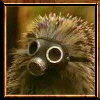
Book 3 of The Shadows of the Apt
Rating: 4 out of 5
How does one follow up on a action-packed grand war epic? Well, Adrian Tchaikovsky did it by making things a little bit mellow in his third book, Blood of the Mantis. After three bloody battles that leveled one city, almost destroyed one, and put another in a practical state of siege, one shouldn’t wonder that the characters of the Shadows of the Apt series are practically exhausted. And, probably, so would the readers, too.
Tchaikovsky quiets things down by making Blood of the Mantis a story of subterfuge and espionage and political wrangling - which doesn’t mean things slow down to a crawl. The Wasp Empire is still on the march, although a little bit jarred on their tracks. While they have taken the industrial city of Helleron and razed the Ant-city of Tark, they lost an Army to an ambush by Mantis warriors, and almost got another destroyed by the Ants of Sarn, if not for the timely arrival of a new powerful weapon, the snapbow, forcing the army of Sarn into retreat in disarray into their city. Now, the Wasps are regrouping and preparing to make the final investment of Sarn all the while keeping an eye on their main prize of Collegium and also towards the exotic Spiderlands.
Meanwhile, in the capital city, plans are set into motion for the recovery of an ancient artifact that may just give to whoever happens to hold it, the power to destroy nations. Magic, it seems, contrary to what people have come to believe is not dead in this world and is preparing to make a huge comeback. Already in this book, the characters indeed find themselves battling shadow-forms that are clearly magical in source.
In order to counter the Wasps, Stenwold Maker, the Beetle-kinden who has now been fighting his own personal war against the Wasps for decades now sends his allies into two directions. He sends Cheerwell and Nero towards the Spider-city of Solarno, while the Achaeos leads Tisamon, Tynisia into a frontier town searching for the missing ancient artifact before it can get to the hands of the enemy, taking with them for assistance two renegade Wasps, the hunter Gaved and one very notorious Major Thalric, formerly of the Rekef. Moreover, Stenwold himself, who through a strange twist of fate came into possession of the plans of the dreaded snapbow, has to decide whether to proliferate it to his “allies” in the Lowlands, who could just as easily use the weapon on one another.
Tchaikovsky ably weaves the plot that is becoming more and more complex as the series moves on without missing a beat. And as before, his strong point remains his characters, as unique as they are; his characters breathe life that complements his plot. More and more, his series is becoming an exploration of man's worst activities: the desire of one society to dominate others for national interests, man's fascination with war as a social means, and the arms race - the desire of man to create more and more complex ways do destroy his own society without ever realizing it.
But with the ever-increasing size and complexity of the plot, the number of significant characters also increases. This means that some of the characters don’t get focused on the current storyline. For this book in particular, it is rather disappointing that Thalric, who was probably the most enigmatic and charismatic character of the previous two books (and an antagonist, at that) is relegated to a background role for this book.
The world-building remains on the surface, too - as it was in the first two books. Sure, there are new and interesting kindens, we get a glimpse of interesting races ready to make major impact on succeeding books, but the readers, as your typical epic fantasy followers, would find themselves wishing there was more background stories concerning these peoples, this cities and cultures, because from what you read, they sure are interesting. One just wishes there is more.
Still, at the end of the day, Tchaikovsky has delivered yet another good installment on the series and a fine contrast to the slam-bang action one went through in Dragonfly Falling. Certainly, he delivers a book where the story, the characters and the world built becomes more and more interesting as the plot progresses. For most of the readers the final chapters will for sure make them wish they had their hands on the next chapter of this wonderful story.

